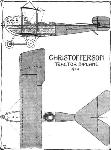Форум Breguet's Aircraft Challenge
Silas Christofferson's 1914 three-place tractor biplane being "tuned up" near Lone Pine, Inyo County, California, in preparation for his historic flight over Mount Whitney (elev: 14,494'). Powered by a 100 h.p. Hall-Scott motor with a cruise speed of +60 mph, the 1914 had a span of 39 ft and was fitted with distinctive tricycle gear. Starting from the Owens Valley, and carrying a camera to capture a few aerial snap-shots, Christofferson crossed the highest point in the lower 48 states at an altitude of roughly 16,000 ft (4877 m) on 25 June 1914. According to some sources the flight had set the world's altitude record - however doubtful considering feats achieved by European aviators of the day. Nevertheless, the "official" American altitude record was set later that summer in Overland Park, Kansas, when on 6 August, Pennsylvania native DeLloyd Thompson flew his Gyro 80 tractor motor Day aeroplane to a dizzying height of 15,256 ft. Although the only 1914 Tractor produced was unsuccessful at the 1914 San Diego military trials, the Christofferson Aircraft Mfg. Co. 1915 Tractor, a V-8 Sturtevant-powered, 47 ft span biplane, based on the Christofferson 1914, prompted orders from the Mexican constitutionalist armies. Quantities delivered are uncertain, but it is recorded that several Christofferson biplanes were in the inventory of the Flotilla Aerea Constitucionalista, - later formed into the Arma de Aviacion Militar del Ejercito Constitucionalista (05 Feb 1915). Silas Christofferson was killed in flying accident on 31 Oct 1916.
Журнал Flight
Flight, November 13, 1914.
AEROPLANE TYPES.
THE CHRISTOFFERSON TRACTOR BIPLANE.
ONE of the machines entered for the U.S. army trials is a 100 h.p. tractor biplane built by the Christofferson Aviation Co. of San Francisco, Cal., the constructors of the Christofferson flying boats. As will be seen from the accompanying sketch-plan and elevation, the design is more or less on German lines, although it possesses distinct features of its own. The planes are built up on two main spars, spaced well apart, somewhat after the fashion of monoplane practice, the rear spar being of small section. Spars and ribs are of spruce, and the wing section also follows monoplane design. The top plane is made up of three sections, being supported on the fuselage by two pairs of vertical tubular steel struts, and a pair of A struts, the latter situated between the rear pair. The outer sections are braced by cabanes, and hinged to the extremities of the rear spar are large-sized ailerons. The lower plane is in two sections, one on either side of and attached to the fuselage. Substantial stranded cable is employed throughout for the wing bracing. The fuselage is of rectangular section, very deep in front, and tapering to a vertical knife edge at the rear. The longitudinals are of spruce and ash, and the struts of the latter material, whilst the whole is cross-braced with stranded cable. Mounted in the nose is a 100 h.p. water-cooled Hall-Scott engine, which is entirely by a beaten aluminium hood, in which area of louvres in front and at the sides for the of admitting air to the radiator mounted the engine. This unusual position of the renders it most accessible, though it appears that the heated air passing from it into the passengers' cock-pit would not be very pleasant, except, perhaps, in cold weather. Underneath the radiator are the fuel and oil tanks, having a capacity for four hours' flight. Immediately behind the radiator, over the centre of gravity, is the passengers' cock-pit, accommodating two side by side, and behind this again is the pilot's cock-pit, situated well at the rear of the main planes, where an excellent view below and around can be obtained. The control consists of a Curtiss-type shoulder-yoke for operating the ailerons, and a rocking column carrying a hand wheel, the former for the elevator and the latter for the rudder. From the nose to the rear of the pilot's cock-pit the fuselage is wood covered, the remaining part being covered with fabric. The stabilising tail plane, to the trailing edge of which are hinged two elevator flaps, can be adjusted as to its angle of incidence. The chassis consists of two pairs of U struts, mounted to the fuselage immediately under the main planes, carrying an axle and pair of wheels, and a pair of V struts attached near the nose of the fuselage, carrying a single wheel. Another pair of struts connects the latter with the U struts. The axle carrying the two wheels is sprung by means of coil springs enclosed in cylindrical casings attached to the U struts. The principal dimensions are as follows:- Span, upper, 39 ft.; lower, 30 ft. 6 ins.; chord, 5 ft. 6 ins.; gap, s ft. 9 ins.; supporting area, 382 sq. ft. ; overall length, 32 ft.; weight, empty, 1,325 lbs.; speed, 35-75 m.p.h.; climbing speed, 4,000 ft. in 10 minutes.
"VEE JAY."




